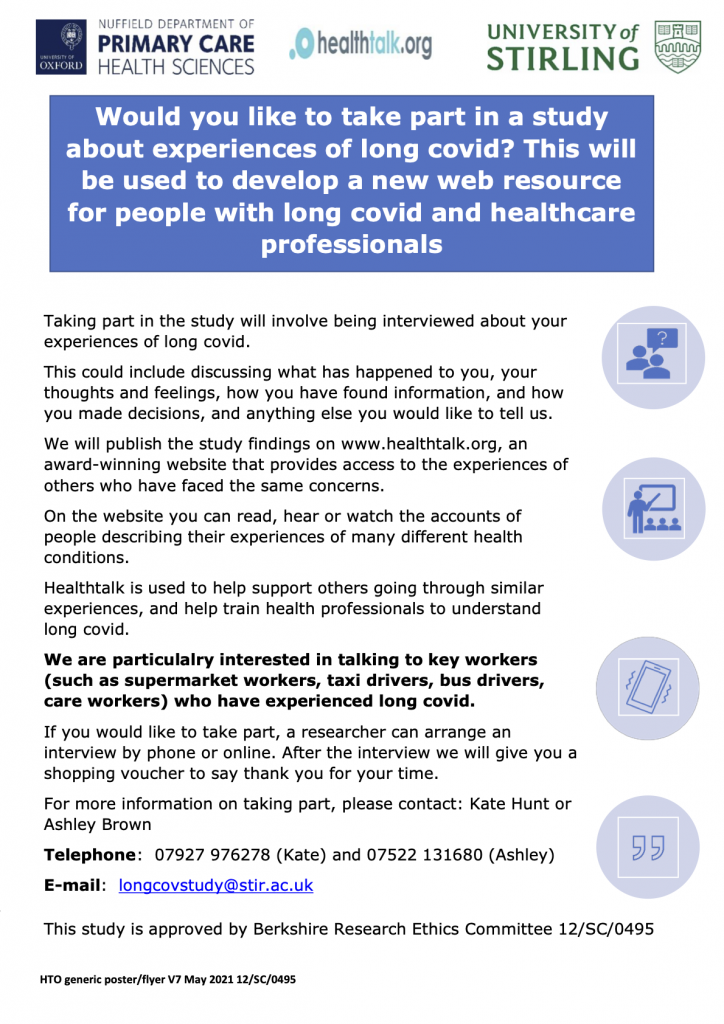More accurate estimates for the burden of Alcohol on the Ambulance Service: around 1 in 6 callouts in Scotland are alcohol related
Written by Francesco Manca and Professor Jim Lewsey, University of Glasgow and Professor Niamh Fitzgerald, University of Stirling and previously published on the Institute of Alcohol Studies website
More than 16% of ambulance callouts in Scotland were alcohol-related in 2019. This is what we found in our new study using data provided by the Scottish Ambulance Service (SAS) and is three times higher than previous estimates. The burden was even higher over weekends (18.5%), peaking on Friday and Saturday nights when the percentage of alcohol-related callouts was 28%.
Alcohol and emergency services
Alcohol constitutes a significant burden on emergency services in the UK, with the potential to undermine or delay emergency service provision to other incidents. This is also true for ambulance services, which often represent patients’ first – and sometimes only – contact with health services. However, there are concerns that current estimates underestimate the actual burden of alcohol for ambulance services.
The study
In a collaboration between the University of Glasgow, SAS, University of Stirling and University of Sheffield, we developed a new approach to identifying alcohol-related ambulance callouts. The approach involves a new algorithm that is integrated into SAS systems to automatically identify alcohol-related callouts using electronic patient records. After every callout, paramedics complete a patient record including free-text fields regarding the circumstances of the callout and patient characteristics. By looking at the most frequent combination of words in callout reports, we built an algorithm capable of classifying ambulance callouts as alcohol-related or not.
Findings
The new method not only provides a much more accurate estimate of the number of alcohol-related callouts, but also enables analysis of trends, location and demographic characteristics of such callouts. For instance, almost two thirds of alcohol-related callouts are to men, which is almost 20% of all ambulance callouts to men. A greater burden of alcohol-related call-outs were to locations in areas with high levels of socio-economic deprivation and on bank holidays, with a peak on the 1st of January which has on average 200 more callouts compared to any other day of the year in Scotland. Beyond the clinical and logistical effort, these callouts also give rise to an economic burden. Our estimate, based on the average cost of an ambulance call-out, is that in 2019 alcohol-related callouts cost almost £31.5m to SAS.
This study adds to the evidence base around the impact of alcohol on society. Furthermore, these data can be used to monitor trends over time and inform alcohol policy decision making both at local and national levels. We are also aware of the potential of similar approaches in other contexts (e.g. ambulance services outside Scotland) or agencies (such as the police) doing similar work.
This work is part of the IMPAACT (The Impact of Minimum Unit Pricing of Alcohol on Ambulance Call-outs in Scotland) study led by Professor Niamh Fitzgerald at the University of Stirling. The work was funded by the Scottish Government Chief Scientist Office (HIPS 18/57) and published in the International Journal of Environmental Research and Public Health.
Monitoring for Health Hazards at Work, 5th Edition
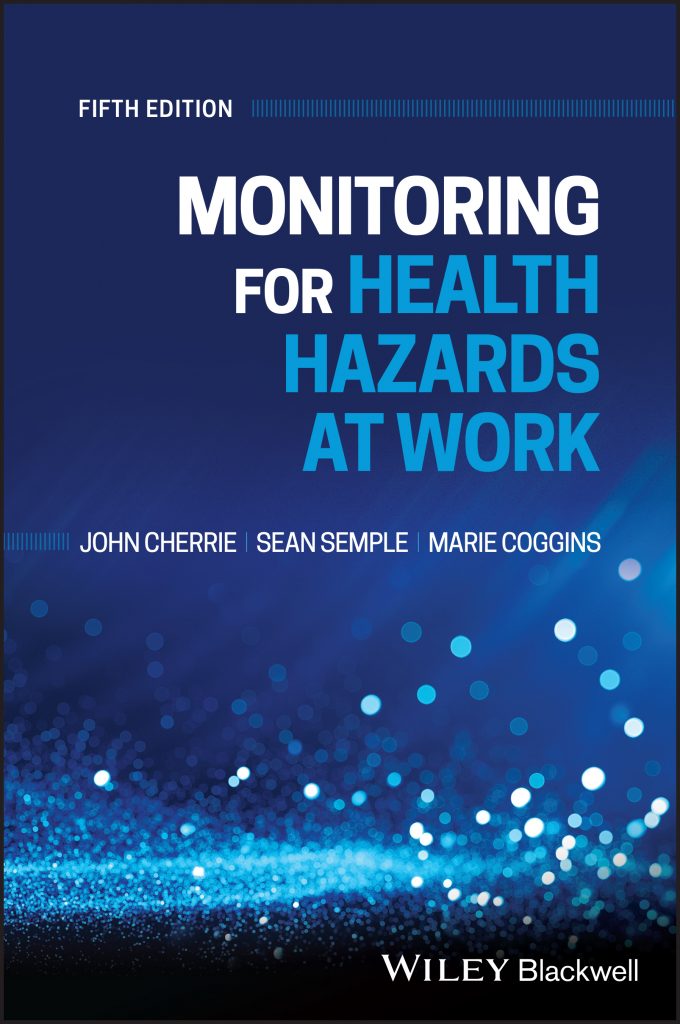
ISMH’s Dr Sean Semple is co-author of a soon-to-be published textbook. This fifth edition of Monitoring Health Hazards at Work is aimed at those studying or carrying out the important task of protecting workers from hazards. It provides a clear explanation of how to approach problems in the workplace: how to identify hazards and how to quantify the risks through measurement. It does this with practical examples and checklists, and leads the reader through the steps required; often highlighting potential issues to avoid problems before they arise. The book covers all types of hazards that arise in the workplace and spans chemical hazards, biological agents and physical hazards. Where appropriate it also considers workplace comfort issues around the thermal environment and lighting. The main emphasis has always been on hazardous substances, which represents the main areas of work for most occupational hygiene practitioners. This revised fifth edition is now split into five sections with several additional new chapters. The book is co-authored with Professor John Cherrie from Heriot Watt University and Dr Marie Coggins from National University Ireland, Galway. It will be available from bookshops and online retailers from the 23rd March 2021.
Declaration of interest: Dr Sean Semple declares a financial interest and will receive royalties from the sale of this book.
Air pollution changes over the course of the day – how does that affect health?
It’s well understood that air pollution changes from place to place and day to day. News stories about bad air pollution in India or China are commonplace. Likewise, if you stand next to an old bus as it’s running, you have a very different experience to the top of Ben Nevis. But what about changes over the course of the day? It surely stands to reason that, if human behaviour affects outdoor air pollution (as it certainly does) then during times when humans are most active, such as the middle of the day, air pollution will be worse?
We set out to investigate this. In a recent open access paper we analysed changes in air pollution outdoors and indoors in Dhaka, Bangladesh over the course of the day in 2018. Dhaka is a large south Asian “megacity” with a population of around 9 million people – about the same as the whole country of Switzerland. Levels of harmful particles (PM2.5) in the air are usually very high, greatly exceeding guidelines from the World Health Organisation and other health authorities. We used data from a monitor installed at the US Embassy in central Dhaka to determine the mean concentration of PM2.5 at each hour of the day in 2018. This let us analyse differences between different times of the day to see when air pollution was at its worst.
What we found was surprising. Rather than having a clear connection to human behaviour – factories or vehicle use, for instance – outdoor air pollution was, on average, much higher at night than during the middle of the day (Figure 1). We didn’t observe an obvious connection between human activity and air pollution, at least at first glance.
Figure 1 – US embassy, Dhaka, PM2.5 measurements by hour, 2018, compared to indoor PM2.5 measurements by hour.
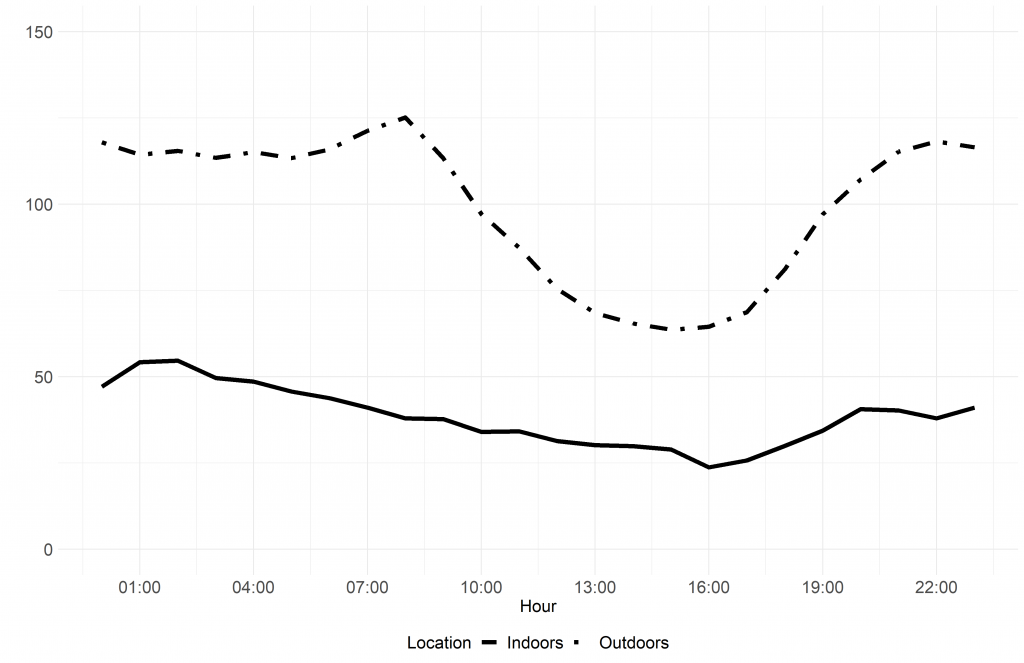
The changes in outdoor concentrations of particulate air pollution clearly aren’t directly associated with the times most people are out in their cars or moving about the city – otherwise we’d see peaks in the morning and evening rush hour and much lower levels at night. Instead it seems more likely that the changes are due, at least in part, to in the interaction between temperature and the atmosphere. Even though air pollution may be dissipating overnight, changes in the atmosphere can push the remaining particles down towards the ground as the air cools, increasing the amount you breathe in and potentially affecting your health. As the air warms again this region of air is drawn upwards, spreading air pollution higher into the atmosphere and diluting how much is measured at ground level.
Indoor air pollution in our homes and offices is also affected by these changes. Looking at data from inside more than 700 homes in Dhaka, we saw a very similar variation to the outdoor US embassy readings over the course of the day. That suggests that much of the PM2.5 air pollution in these homes is directly linked to outdoor air pollution (something that isn’t necessarily true in homes in countries like Scotland, where outdoor air pollution is low).
While interesting, this information itself doesn’t tell us whether this affects people’s exposure to air pollution – the amount they actually breathe in, and therefore the air pollution that does them harm. But there are troubling possibilities. Breathing in PM2.5 is connected to acute cardiovascular illness, so could easily precipitate heart attacks in vulnerable people. If that happens more often at night (when emergency medicine and care resources are fewer) that may lead to more deaths. Once we know more about when air pollution is worst, we might be able to change policy to protect more people from ill-health. Environmental scientists have long been aware of effects like this, so it’s important that health researchers take them into account when measuring air pollution exposure to influence policy.
This study looked at Dhaka and a number of other cities in the global south. When we compared our data to outdoor air in London, Paris and New York we found no similar effect. As researchers in high-income countries, it’s important that we don’t simply import our pre-existing understanding of how air pollution works to places where the circumstances are different – particularly when we’re working with local researchers designing studies to measure air quality or examine health impacts from pollution.
Human beings affect air quality in many ways in different places – it can be much more complicated than we first think! If we want to get air pollution exposure monitoring right, we need to understand both the places and the people we’re measuring.
The paper, “Diurnal variability of fine-particulate pollution concentrations: data from 14 low- and middle-income countries” has been published in the International Journal of Tuberculosis and Lung Disease. This study was funded by the UK Medical Research Council (London, UK) under the Global Alliance for Chronic Diseases (GACD) research programme (MR/P008941/1).
New evidence review: alcohol screening and brief intervention in primary health care
A new open-access paper in Implementation Science, co-authored by ISMH colleagues, is the first review worldwide to identify the theoretical underpinnings of what keeps primary healthcare doctors and nurses from advising alcohol consumers on cutting down.
Alcohol is a leading global risk factor for disease and premature death. Evidence shows that although many drinkers would cut down or stop drinking if advised to do so by a primary health care doctor or nurse, the vast majority of them leave their primary care appointment without being screened and/or advised.
The study, led by Dr. Frederico Rosário of the University of Lisbon, was a systematic review of the literature to identify the barriers and facilitators to the delivery of alcohol screening and brief interventions in primary care. Alcohol brief interventions are short, non-confrontational conversations aiming to motivate drinkers to reduce their consumption and/or their risk of harm. Alcohol brief interventions have historically been preceded by the use of a screening questionnaire to assess an individual’s consumption level and risk of alcohol problems. The authors used behaviour change theory to provide a better understanding of how the barriers could be addressed in order to change practitioners’ behaviour.

The review found multiple barriers to implementation of alcohol screening and brief intervention delivery. Lack of time, low sense of self-efficacy (confidence in their abilities) and lack of specific knowledge and training were among the most commonly found. The findings show the multiple factors underpinning the low delivery of alcohol screening and brief interventions by primary care practitioners, suggesting that more complex implementation programmes addressing several barriers may be needed to successfully change practitioners’ behaviour. The findings from this study were used to design and trial a programme to increase the rates of alcohol screening and brief intervention delivery in primary care, the results of which are expected soon.
Dr. Frederico Rosário led the study and was co-supervised in his PhD by ISMH Director, Niamh Fitzgerald and Cristina Ribeiro of the University of Lisbon. This review also involved ISMH’s information specialist Kathryn Angus, and colleagues Maria Inês Santos of the Hospital Casa de Saúde São Mateus and Leo Pas of the Catholique University of Leuven. Link to the open-access paper: https://doi.org/10.1186/s13012-020-01073-0
New report examining adolescent awareness of unhealthy food marketing
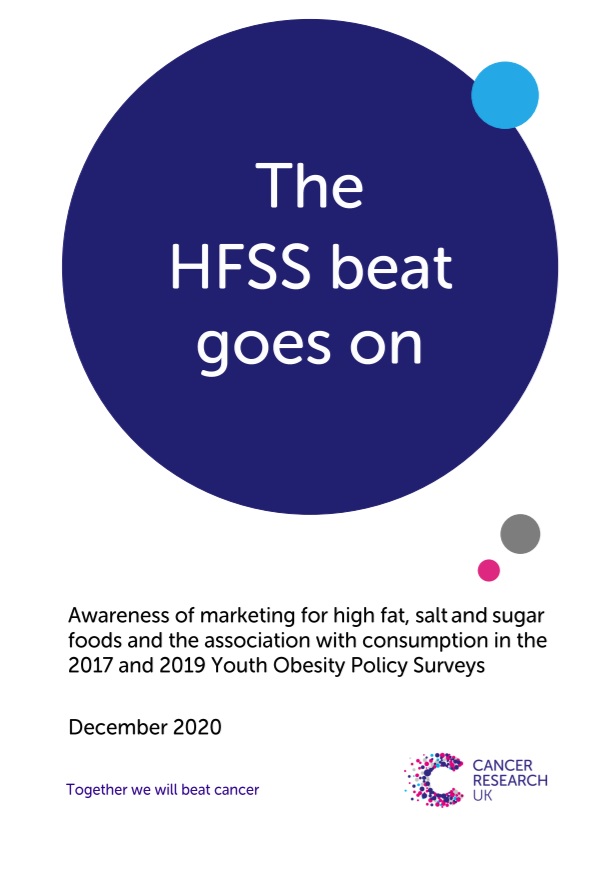
Cancer Research UK, in collaboration with ISMH’s Nathan Critchlow, have published a new report examining awareness of marketing for unhealthy food and drinks and the association with monthly consumption of food and drinks high in fat, salt and/or sugar (HFSS).
The data come from the first two waves of the Youth Obesity Policy Survey (YOPS). This study is modelled on ISMH’s long-running Youth Tobacco Policy Survey (YTPS), a repeat-cross-sectional study that has made significant contributions to the implementation and evaluation of leading tobacco control policy in the UK.
The first wave of the YOPS was conducted in 2017 and the second wave in 2019. In each wave, data came from around 3,300 11-19 year olds from across the UK, who are recruited by YouGov. Adolescents are asked a variety of questions relating to diet and obesity, including where and how often they recall seeing marketing for unhealthy foods and their HFSS consumption.
The data suggest that little has changed in the past two years. In both waves, around nine-in-ten adolescents recalled seeing at least one instance of HFSS marketing in the past month, at least half of adolescents were estimated to see 2-3 instances of HFSS marketing a day, and higher awareness of HFSS marketing was associated with increased consumption for a variety of HFSS food and drinks.
The UK Government have committed to, or are consulting on, a range of new marketing control policies for HFSS foods. These include a 9pm watershed and a ban on online advertising. This report builds on existing evidence highlighting exposure to HFSS marketing among young people, and support the swift implementation of these proposed policies.
The full report can be read here and the executive summary here.
The report should be cited as:
Newman, A., Newberry Le Vay, J., Critchlow, N., Froguel, A., & Clark, M., & Vohra, J. (2020). The HFSS beat goes on: Awareness of marketing for high fat, salt, and sugar foods and the association with consumption in the 2017 and 2019 Youth Obesity Policy Surveys. London, UK: Cancer Research UK.
Supporting smokers experiencing homelessness to stop smoking
ISMH, with colleagues at London South Bank University, have conducted the first study in the UK to engage smokers accessing homeless services in smoking cessation support, and the first study worldwide to explore the feasibility of supplying free e-cigarette starter kits at homeless centres. Smoking prevalence amongst adults experiencing homelessness is four times higher than the UK national average. Evidence shows that although many homeless smokers would like to quit, they are less likely to engage with traditional stop smoking services, make fewer quit attempts and are less likely to stop smoking. The study team worked with four homeless centres across Scotland and England. Participants in two centres received advice to quit and signposting to the local Stop Smoking Service. In another two centres they received a free e-cigarette starter kit and 4-weeks supply of e-liquid. We found that offering stop smoking interventions within homeless support centres overcame some of the barriers this vulnerable population faces when engaging with traditional cessation approaches. As the study results were promising in terms of recruitment and follow-up of participants, and effectiveness of providing an e-cigarette starter kit to homeless smokers, these findings will now inform a possible future larger trial. Dr Allison Ford at ISMH led the Scottish arm of the study, supported by Dr Isabelle Uny and Dr Catherine Best.
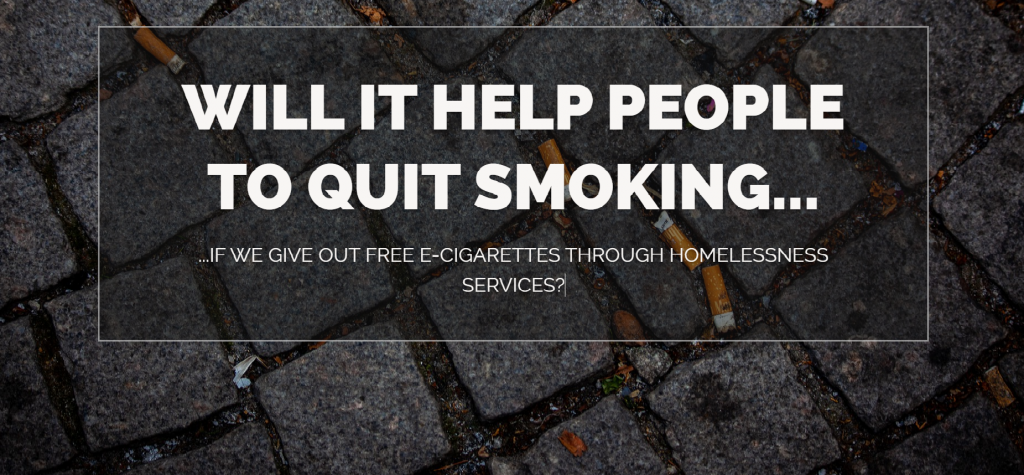
A lay summary of the findings from our study can now be found here: https://spark.adobe.com/page/lk6yaCQILAsJY/ and the academic publication here: https://doi.org/10.1371/journal.pone.0240968
Findings from the feasibility study will be presented by Dr Allison Ford (ISMH) and Prof Lynne Dawkins (feasibility study PI, LSBU) at the Leaving no Smoker Behind event on 19th January 2021. Find further details including how to sign up here:
https://www.eventbrite.co.uk/e/leaving-no-smoker-behind-tickets-90789857909
New report examining implementation of plain packaging in the UK
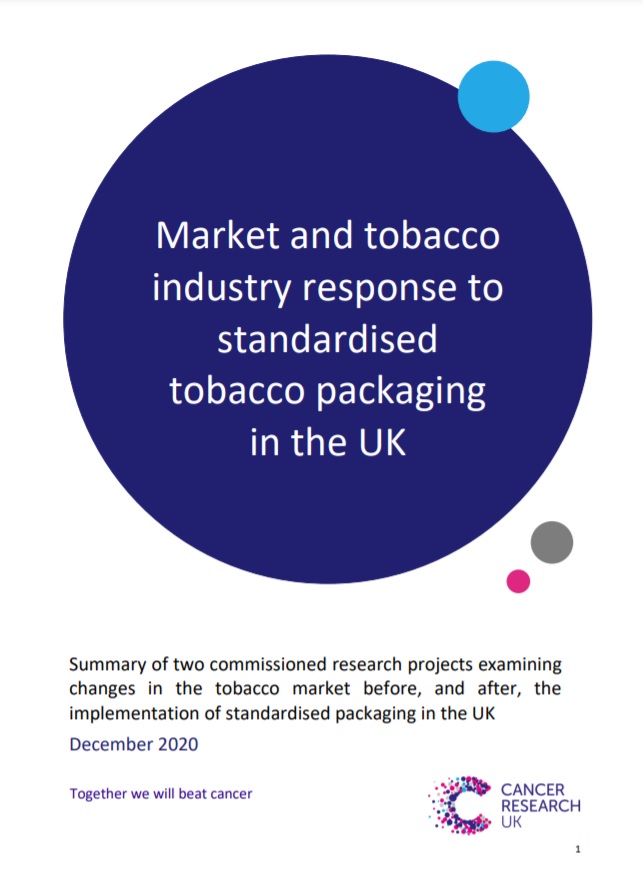
The Institute for Social Marketing and Health played a key role in creating and reviewing evidence that led to the implementation of standardised (plain) packaging in the UK. We are also now playing a leading role evaluating the impact the policy has had on young people, adult consumers, and the tobacco market.
Last week saw the publication of a new Cancer Research UK (CRUK) report based on some our early evaluation evidence. Specifically, the report summarises two projects commissioned by CRUK to examine how retailers and tobacco companies responded to standardised packaging. We conducted one of the studies, examining implementation in small retailers. The ISMH research was led by Martine Stead, and involved Nathan Critchlow, Douglas Eadie, Anne Marie MacKintosh, Kathryn Angus and Crawford Moodie. The second study, examining implementation across the UK tobacco market (including larger retailers such as supermarkets), was conducted by the Tobacco Control Research Group at the University of Bath. This project was led by Anna Gilmore, Rosemary Hiscock and colleagues.
The findings and recommendations provide a comprehensive summary of market changes before, during and after, the implementation of standardised packaging. Several findings of note from the ISMH research are:
- Tobacco companies used the full 12-month transition period to delay the removal of fully-branded tobacco products from the market. This prolonged use of this important marketing tool until compliance was mandatory.
- Tobacco companies used the full 12-month transition period to delay and then only gradually introduce products in standardised packaging. This tactic may have mitigated some of the immediate intended effects of the legislation by gradually desensitising consumers to the new unattractive designs.
- The prices for leading tobacco products increased as standardised packaging was implemented. These rises are at odds with tobacco companies’ claims that standardised packaging would lead to lower prices, therefore increasing the affordability of tobacco and, subsequently, consumption. Conversely, in fact, our data suggested that Recommended Retail Prices (RRPs) also increased, which implies it was the tobacco companies who instigated the price rises.
The full report, including Bath’s findings, is well worth a read. We hope the conclusions will contribute to the UK Government’s post-implementation review of standardised packaging (due soon) and provide useful context to other evaluation studies. The report also includes a list of the academic publications that report the findings in detail from both the Stirling and Bath projects.
ISMH is also conducting a range of other evaluation studies. You can read some of our research papers examining how adolescents, a key target audience for prevention, have reacted to the policy here and here. You can read some of our research examining impacts among adult consumers here, here, and here. You can also read some of our policy research on this legislation by clicking here, here, and here.

